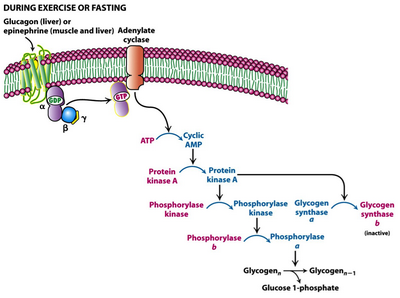Question #ad36a
1 Answer
The main enzyme of glycogenolysis is glycogen phosphorylase.
Explanation:
Glycogenolysis
Glycogenolysis is the step-wise removal of glucose units from glycogen to form glucose-6-phosphate.
There are two steps in the process.
1.
2.
Glycogenolysis plays an important role in the fight-or-flight response and in the regulation of glucose levels in the blood.
The Signalling Pathway
The signalling pathway consists of several steps.

(from www.studyblue.com)
1. The pancreas secretes glucagon when the blood sugar is low.
2. Glucagon activates receptors in the cytoplasmic membrane.
3. The receptors activate adenylate cyclase.
4. The adenylate cyclase converts ATP to cyclic AMP (cAMP).
5. cAMP binds to and activates protein kinase A (PKA).
6. PKA activates phosphorylase kinase.
7. Phosphorylase kinase activates glycogen phosphorylase.
8. Glycogen phosphorylase activates glycogenolysis.

